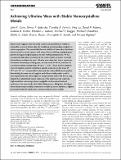Achieving Ultralow Wear with Stable Nanocrystalline Metals
Author(s)
Curry, John F; Babuska, Tomas F; Furnish, Timothy A; Lu, Ping; Adams, David P; Kustas, Andrew B; Nation, Brendan L; Dugger, Michael T; Chandross, Michael; Clark, Blythe G; Boyce, Brad L; Schuh, Christopher A; Argibay, Nicolas; ... Show more Show less
DownloadPublished version (2.495Mb)
Terms of use
Metadata
Show full item recordAbstract
© 2018 National Technology & Engineering Solutions of Sandia, LLC. Published by WILEY-VCH Verlag GmbH & Co. KGaA, Weinheim Recent work suggests that thermally stable nanocrystallinity in metals is achievable in several binary alloys by modifying grain boundary energies via solute segregation. The remarkable thermal stability of these alloys has been demonstrated in recent reports, with many alloys exhibiting negligible grain growth during prolonged exposure to near-melting temperatures. Pt–Au, a proposed stable alloy consisting of two noble metals, is shown to exhibit extraordinary resistance to wear. Ultralow wear rates, less than a monolayer of material removed per sliding pass, are measured for Pt–Au thin films at a maximum Hertz contact stress of up to 1.1 GPa. This is the first instance of an all-metallic material exhibiting a specific wear rate on the order of 10−9 mm3 N−1 m−1, comparable to diamond-like carbon (DLC) and sapphire. Remarkably, the wear rate of sapphire and silicon nitride probes used in wear experiments are either higher or comparable to that of the Pt–Au alloy, despite the substantially higher hardness of the ceramic probe materials. High-resolution microscopy shows negligible surface microstructural evolution in the wear tracks after 100k sliding passes. Mitigation of fatigue-driven delamination enables a transition to wear by atomic attrition, a regime previously limited to highly wear-resistant materials such as DLC.
Date issued
2018Department
Massachusetts Institute of Technology. Department of Materials Science and EngineeringJournal
Advanced Materials
Publisher
Wiley